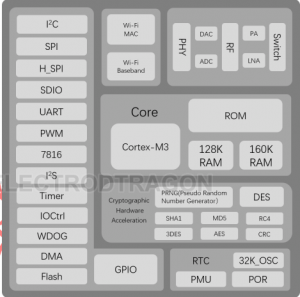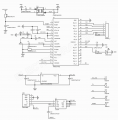W600
Hardware
Brief
- This chip is a SoC chip that supports multi-interface, multi-protocol wireless LAN IEEE802.11n (1T1R). Applicable to IoT applications such as smart home appliances, smart homes, wireless audio and video, smart toys, medical monitoring, industrial control, etc.
- The SoC chip integrates Cortex-M3 core, built-in Flash, integrated RF transceiver front-end RF Transceiver, CMOS PA power amplifier, baseband processor/media access control, supports SDIO, SPI, UART, GPIO, I2C, PWM, I2S, 7816 and other interfaces Support multiple encryption and decryption protocols, such as PRNG (Pseudo random Number Generator) / SHA1/ MD5 / RC4 / DES / 3DES / AES / CRC.
Specifications
Chip appearance: QFN32 package, 5mm x 5mm
Chip integration
- integrated 32-bit embedded Cortex-M3 processor, operating frequency 80MHz;
- Integrated 288KB data storage;
- Integrated 1MB FLASH;
- Integrated 8-channel DMA controller, support any channel allocated for hardware use or software use, support 16 hardware applications, support software linked list management;
- Integrated 2.4G RF transceiver to meet the IEEE802.11 specification;
- Integrated PA / LNA / TR-Switch;
- Integrated 32.768KHz clock oscillator;
- Integrated voltage detection circuit;
- Integrated LDO;
- Integrated power control circuit;
- Integrated power-on reset circuit;
- Integrated universal encryption hardware accelerator, support for multiple encryption and decryption protocols such as PRNG (Pseudo Random Number Generator) / SHA1 / MD5 / RC4 / DES / 3DES / AES / CRC.
Interface
- Integrated 1 SDIO2.0 Device controller, support SDIO1 bit / 4 bit / SPI three operating modes; working clock range 0~50MHz;
- Integrated 2 UART interfaces, support RTS/CTS, baud rate range 1200bps~2Mbps;
- Integrates a high-speed SPI device controller with an operating clock range of 0~50MHz;
- Integrated with 1 SPI master/slave interface, the main device operating frequency supports 20Mpbs, and the slave device supports 6Mbps data transmission rate;
- Integrated with an I 2 C controller supporting 100/400Kbps speed;
- Integrated GPIO controller;
- Integrated PWM controller with 5 PWM outputs or 2 PWM inputs. The highest output frequency is 20MHz, and the highest input frequency is 20MHz.
- Integrated duplex I2S controller supporting 32KHz to 192KHz I2S interface codec;
- Integrated 7816 interface, support ISO-7816-3 T=0/1 mode, support EVM2000 specification, and compatible with serial port function.
Protocol and function
- Support GB15629.11-2006, IEEE802.11 b/g/n/e/i/d/k/r/s/w;
- Support WAPI2.0;
- Support Wi-Fi WMM/WMM-PS/WPA/WPA2/WPS;
- Support for Wi-Fi Direct;
- Support EDCA channel access mode;
- Support 20/40M bandwidth working mode;
- Support STBC, GreenField, Short-GI, support reverse transmission;
- Support RIFS frame interval;
- Support AMPDU, AMSDU;
- Support IEEE802.11n MCS 0~7, MCS32 physical layer transmission rate gear, the transmission rate is up to 150Mbps;
- Support for Short Preamble at 2/5.5/11Mbps rate delivery;
- Support HT-immediate Compressed Block Ack, Normal Ack, No Ack response mode;
- Support CTS to self;
- AP support functions;
- Supported as both AP and STA;
- In a BSS network, multiple multicast networks are supported, and each multicast network is supported in different encryption modes. The maximum number of multicast networks and the STAs that are connected to the network can be up to 32.
- When BSS network support is used as an AP, the total number of supported sites and groups is 32, and 16 sites are supported in the IBSS network;
- Receive sensitivity:
- 20MHz MCS7@-71dBm;
- 40MHz MCS7@-68dBm;
- 54Mbps@-73dBm;
- 11Mbps@-86dBm;
- 1Mbps@-95dBm;
- Allowable carrier frequency deviation: 50ppm;
- Allowable sampling frequency deviation: 50ppm;
- Support different encryption modes STA communication;
- Support a variety of different receive frame filtering options;
- Support for monitoring.
Power Consumptions
- 3.3V single power supply;
- Support PS-Poll and U-APSD power management;
- SoC chip standby current is less than 10uA.
Schematic
Software
- AT commands: commands list fully compatible with ESP8266
Reference
- All documentation please see here https://github.com/hechao/W600.git





